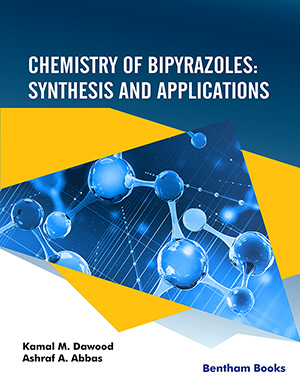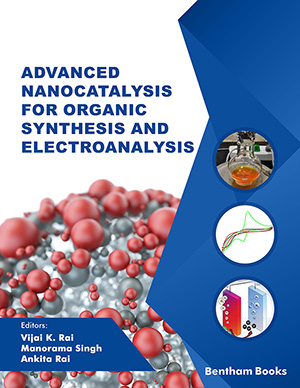
Abstract
Cancer is one of the leading causes of death worldwide. Mutation of the cell regulates genes and protein causing cancer. Surgery, radiotherapy, and the use of anticancer agents are the current therapy of cancer despite their side effects. The general area of research relates to heterocyclic chemistry. The purpose of the article is to review the most recent advances in nitrogen-containing heterocyclics as possible chemotherapy agents for cancer. More than 90% of the novel drugs bear heterocyclics and among them, nitrogencontaining heterocyclic compounds show superior pharmaceutical effect than non-nitrogen compounds. Nitrogen-containing compounds, the heart of drug discovery, present a significant and valuable group of molecules that play a chief and vital role in the metabolism of living cells.
Keywords: Anticancer, heterocyclic, nitrogen-containing heterocyclic, natural nitrogen-containing heterocyclic, synthetic nitrogencontaining heterocyclic, chemotherapy agents.
Current Organic Chemistry
Title:Anti-cancer Nitrogen-Containing Heterocyclic Compounds
Volume: 22 Issue: 23
Author(s): Zahra Hosseinzadeh, Ali Ramazani*Nima Razzaghi-Asl
Affiliation:
- Department of Chemistry, University of Zanjan, P.O. Box 45195-313, Zanjan,Iran
Keywords: Anticancer, heterocyclic, nitrogen-containing heterocyclic, natural nitrogen-containing heterocyclic, synthetic nitrogencontaining heterocyclic, chemotherapy agents.
Abstract: Cancer is one of the leading causes of death worldwide. Mutation of the cell regulates genes and protein causing cancer. Surgery, radiotherapy, and the use of anticancer agents are the current therapy of cancer despite their side effects. The general area of research relates to heterocyclic chemistry. The purpose of the article is to review the most recent advances in nitrogen-containing heterocyclics as possible chemotherapy agents for cancer. More than 90% of the novel drugs bear heterocyclics and among them, nitrogencontaining heterocyclic compounds show superior pharmaceutical effect than non-nitrogen compounds. Nitrogen-containing compounds, the heart of drug discovery, present a significant and valuable group of molecules that play a chief and vital role in the metabolism of living cells.
Export Options
About this article
Cite this article as:
Hosseinzadeh Zahra, Ramazani Ali*, Razzaghi-Asl Nima, Anti-cancer Nitrogen-Containing Heterocyclic Compounds, Current Organic Chemistry 2018; 22 (23) . https://dx.doi.org/10.2174/1385272822666181008142138
| DOI https://dx.doi.org/10.2174/1385272822666181008142138 |
Print ISSN 1385-2728 |
| Publisher Name Bentham Science Publisher |
Online ISSN 1875-5348 |
Call for Papers in Thematic Issues
Catalytic C-H bond activation as a tool for functionalization of heterocycles
The major topic is the functionalization of heterocycles through catalyzed C-H bond activation. The strategies based on C-H activation not only provide straightforward formation of C-C or C-X bonds but, more importantly, allow for the avoidance of pre-functionalization of one or two of the cross-coupling partners. The beneficial impact of ...read more
Electrochemical C-X bond formation
Conventional methods for carrying out carbon–X bond formation are typically conducted at harsh reaction conditions, and rely on expensive catalysts as well as the use of stoichiometric, and perhaps toxic, oxidants. In this regard, electrochemical synthesis has recently been recognized as a sustainable and scalable strategy for the construction of ...read more
From Lab Bench to Algorithm: The Future of Organic Chemistry Powered by AI
Organic chemistry, with its intricate dance of molecules and reactions, is undergoing a transformation fuelled by the power of Artificial Intelligence (AI) and Machine Learning (ML). The integration of AI/ML with Organic Chemistry is revolutionizing the field by enhancing the efficiency and accuracy of chemical research and development. These technologies ...read more
N-Heterocyclics: Synthesis, Computational Studies, and Coordination Chemistry - A synthetic perspective
N-heterocycles, such as phenanthroline, quinoline, or their organometallic complexes, are widely used in a variety of fields, including chemistry, biochemistry, and coordination chemistry. They play a key role in many chemical and biological processes as biological ligands, medicinal agents, catalysts in organic synthesis, molecular probes and sensors, as well as ...read more
Related Journals
 160
160 15
15
- Author Guidelines
- Graphical Abstracts
- Fabricating and Stating False Information
- Research Misconduct
- Post Publication Discussions and Corrections
- Publishing Ethics and Rectitude
- Increase Visibility of Your Article
- Archiving Policies
- Peer Review Workflow
- Order Your Article Before Print
- Promote Your Article
- Manuscript Transfer Facility
- Editorial Policies
- Allegations from Whistleblowers
- Announcements
Related Articles
-
Interactome Analysis of the Differentially Expressed Proteins in Uterine Leiomyoma
Anti-Cancer Agents in Medicinal Chemistry Human Apurinic/Apyrimidinic Endonuclease (APE1): An Emerging Anti-Cancer Biomarker
Recent Patents on Biomarkers The Role of Kallikrein 7 in Tumorigenesis
Current Medicinal Chemistry Cutting through the Complexities of mTOR for the Treatment of Stroke
Current Neurovascular Research Segmentation and Classification of Lung Cancer: A Review
Immunology, Endocrine & Metabolic Agents in Medicinal Chemistry (Discontinued) Roles of AFAP1-AS1 in Gynecology and Urogenital System
Current Pharmaceutical Design Hybrid Compounds & Oxidative Stress Induced Apoptosis in Cancer Therapy
Current Medicinal Chemistry Cancer Immunotherapy: Battling Tumors with Gene Vaccines
Current Medicinal Chemistry - Anti-Inflammatory & Anti-Allergy Agents Oxidative stress in carcinogenesis: new synthetic compounds with dual effects upon free radicals and cancer.
Current Medicinal Chemistry New Improved Drug Delivery Technologies for Pentacyclic Triterpenes: A Review
Protein & Peptide Letters Cervical Cytology and Herpes Simplex Virus Type-2 Serology Among Human Immune Deficiency Virus Infected Women on Highly Active Antiretroviral Therapy in Enugu, Nigeria
Current HIV Research Oncostatin M: Potential Implications for Malignancy and Metabolism
Current Pharmaceutical Design Homologation: A Versatile Molecular Modification Strategy to Drug Discovery
Current Topics in Medicinal Chemistry High Mobility Group Box-1 (HMGB1): A Potential Target in Therapeutics
Current Drug Targets Self-Adjuvanting Therapeutic Peptide-Based Vaccine Induce CD8<sup>+</sup> Cytotoxic T Lymphocyte Responses in a Murine Human Papillomavirus Tumor Model
Current Drug Delivery Fe3O4 Nanoparticles Mediated Synthesis of Novel Isatin-dihydropyrimidinone Hybrid Molecules as Antioxidant and Cytotoxic Agents
Anti-Cancer Agents in Medicinal Chemistry Radiation and Gene Therapy: Rays of Hope for the New Millennium?
Current Gene Therapy Strategies for the Biological Evaluation of Gold Anticancer Agents
Anti-Cancer Agents in Medicinal Chemistry Screening of Selected Cultivars of Sweet Sorghum for Phytochemicals and <i>In vitro</i> Evaluation of Their Antihyperglycemic and Cytotoxic Activity
Current Bioactive Compounds Patent Selections
Recent Patents on Anti-Cancer Drug Discovery























